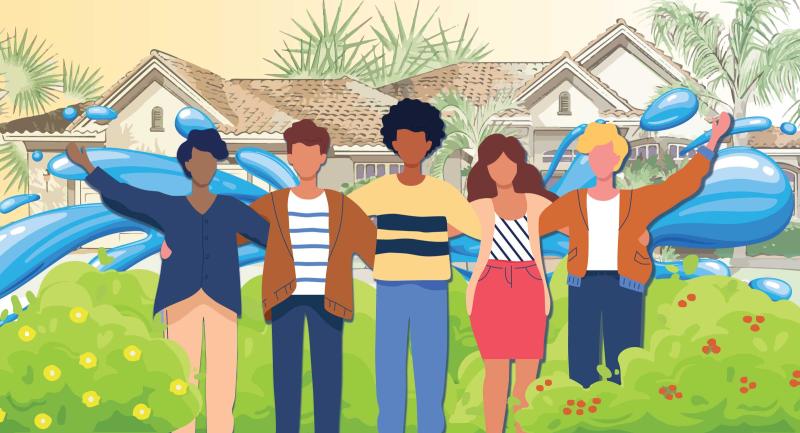One of the best places to take on actions that help protect water quality and conserve water resources is in your own yard. If you’re not allowed to or don’t have a yard, check in with your teachers to see if you and your friends can make positive changes right at school! Small changes outdoors can make a big difference in protecting Florida’s environment and keeping your local watershed healthy.
The number of people moving to Florida is growing every day. That means there is a lot of natural habitats being taken over by new housing developments. Most of these houses still have traditional grass lawns, which have been around since the olden days (1870s) and became especially popular in the 1950’s.
Traditional lawn landscapes can take a lot of work and money to maintain. They can also negatively impact the environment and water resources by:
- Using up space that Florida’s native plants and animals need.
- Using fertilizers or harmful pesticides and herbicides that can run off into nearby ponds and streams, or seep down in the groundwater.
- Using a lot of our freshwater supply for irrigation.
Being a water superhero means recognizing that there is more to a yard than just grass and working to create a landscape that is Florida friendly! That’s where Florida Friendly LandscapingTM (FFL) comes in. FFL is a statewide program that uses science-based research to encourage environmentally-friendly landscape practices. Learn more about the nine principles of FFL below.
Florida-Friendly Landscaping Principles
1. Right Plant, Right Place
Choosing the right plant for the right place means picking plants that match the location well. Plants that fit their location require less water, fertilizers, pesticides, and maintenance. Check the below factors when researching the right plant for the right place:
- What type of soil does the plant need to grow?
- Does the plant need a location with full sun or shade?
- Does the plant need very wet soil or a dry location?
When possible, select native plants for your landscape. Native plants are those that naturally exist in an area and are already adapted to the climate, soil and weather. Choosing plants that are native to Florida means they are accustomed to growing here without help from people. You can also look for drought-tolerant plant species that don’t require a lot of water to thrive!
Having grass is okay if you use it, but you may not need a whole yard full. Instead, think about replacing some of the turfgrass with plant beds that include native, drought-tolerant species that match site conditions. Make sure to do your research beforehand and avoid using invasive plants that can steal water and crowd out native species.
2. Water Efficiently
It is important to water lawns and plant beds only when needed. Overwatering can happen easily and results in wasted water, polluted runoff and makes plants more likely to get diseases or pests. Follow these tips to be a smart water user outdoors.
- Look for signs that your lawn needs water. This includes grass that has a bluish-gray color, when leaf blades are folded in half lengthwise, or if footprints stay in the grass after walking on it.
- Be mindful of the season. A lawn doesn’t need to be watered much in the winter when it’s cool, or during the summer when it rains a lot.
- Don’t water in the rain (singing is OK). If your yard has a sprinkler system, make sure there is a rain shutoff device. And if it’s supposed to rain tomorrow, why water today?
- Water at the right time. It is recommended to water before 10 a.m. or after 6 p.m. In the middle of the day the sun is shining and creating more heat, which means water is more likely to evaporate into the air instead of soaking into the ground.
- Make upgrades to improve water use. Certain practices outdoors can help to save water. For example, putting micro-irrigation in plant beds, checking rain sensors, or installing a soil moisture sensor can all help to reduce water waste.
3. Fertilize Appropriately
Fertilizer is like food for plants, providing nutrients to help them grow. Plants are usually able to get the nutrients they need from soil, but sometimes they need a little boost to thrive. Fertilizer comes in a variety of forms, like compost, liquids and pellets. For lawns, most people use chemical fertilizers. Although fertilizers can be helpful, many people use too much.
Using the right amount of fertilizer on grass and other plants is very important. Too much fertilizer can:
- Make pests more pesty.
- Cause your lawn to grow too quickly.
- Make your lawn even thirstier for water.
Too much fertilizer can also travel away from our lawns. It can seep into groundwater or get picked up by the rain and run off into nearby surface waters. Once it gets into creeks, ponds or even the ocean, it makes algae in the water grow. That can make the water green and soupy, and even use up all the oxygen and kill fish!
4. Mulch
Mulch is loose material that you can spread on top of soil. Bark is one of the most common types of mulch. People sometimes use mulch in their gardens between plants or where grass doesn’t grow well.
Florida-friendly landscapes often use a lot of mulch. Why is mulch so great?
- Mulch that comes from plants (organic) will provide food for the plants you are growing.
- Mulch keeps your soil warmer in winter and cooler in summer.
- Mulch keeps the soil beneath it from drying out — so you don’t need to water as much.
- Fresh mulch makes it hard for weeds to grow.
- If you use mulch for a while, it will break down and make your sandy soil better for plants.
Did you know you can get mulch from your own yard using cut grass and tree leaves?
5. Attract Wildlife
With all the people that live in Florida now, there’s less space for wild animals and plants. Your yard might be part of the problem — but it could also help! By having more than just a grassy lawn, Florida-friendly yards provide food and shelter for wildlife like birds and butterflies.
Some people like butterflies so much they design gardens just for them. They plant certain flowers that butterflies like, and others that the caterpillars prefer to munch on. Other people love birds, so they choose trees, shrubs and grasses that have seeds, berries, nuts and fruit that birds like to eat.
Click here if you want more information on landscaping for Florida's wildlife.
6. Manage Yard Pests Responsibly
Bugs really bother some people, so they use nasty chemicals to kill them. Florida-friendly yards use IPM — integrated pest management. IPM helps gardeners to manage pests with as few chemicals as possible. That means nasty chemicals are a last resort. Here are some IPM practices:
- Plant healthy, native plants that are already resistant to pests and don’t need chemicals.
- If problems do arise, remove affected leaves or plant parts, or pick the insets off by hand.
- If you must use a pesticide, use spot-treatment only to target a specific area, rather than covering your whole yard.
You don’t want to get rid of all the bugs in your yard — plenty of birds love to eat bugs! In a diverse, Florida-friendly yard, there will be plenty of “good” insects to eat the “bad” ones that might harm your plants.
What sort of pests could you find in your yard? For more information on bad critters with fun names like “thrips” and “mealybugs,” click here.
7. Recycle Yard Waste
Yards generate yard waste like leaves and grass clippings. Some people think yard waste is just more garbage, but others know it makes valuable mulch and compost. Here are two ways to keep your landscaping waste in your yard where it belongs.
- Tip 1: Make sure the grass clippings stay on your lawn when you mow. They’ll help feed the lawn so you won’t need as much fertilizer.
- Tip 2: Compost — it’s the best way to feed your yard. Some types of yard waste can be turned into rich, nutritious soil. You can even include vegetable leftovers from your kitchen, like carrot tops, coffee grounds and apple cores.
Making compost can be easy. All you really need to do is toss yard and kitchen waste into a pile and let it happen! If you prefer gadgets, there are all kinds of drums, bins and other containers to help create and hold compost.
8. Reduce Stormwater Runoff
When it rains it pours in Florida, which creates a lot of stormwater runoff. Stormwater runoff occurs when rainwater picks up pollution as it washes over roads, parking lots, driveways, roof tops and other hard surfaces where it cannot soak into the ground. The untreated runoff ends up in nearby waterbodies, along with the many different pollutants it picked up along the way.
Examples of pollution that can become a part of stormwater runoff include the fertilizers and pesticides that we use on our yards, or even doggie doo we don’t pick up. It can have many harmful effects when those types of pollutants enter a water body in large quantities.
Make Every Raindrop Count!
A well-designed, Florida-friendly yard will soak up the rain that falls onto it. That way storm water will not run off — it will be filtered before it causes problems. How can you reduce the amount of rain that runs off your yard?
- Make sure downspouts from your roof empty into your yard, not onto driveways or other hard surfaces where the water will just run off.
- Use rain barrels to collect water during a rain event that can be reused to water plants.
- Use gravel and mulch for paths or driveways to help rainwater sink into the ground instead of rushing away like it would on pavement or asphalt.
- Always use fertilizer appropriately.
9. Protect the Waterfront
Florida has a lot of water, which means there are many homes with waterfront yards. Some yards may be right next to the ocean, a big lake or a coastal lagoon, while others have canals that connect to the ocean or lakes. Many homes are also located along rivers, creeks, natural ponds or wetlands. Some yards even include seasonal ponds or retention ponds created by bulldozers. All that waterfront property is great, but if your yard includes water, you have to be extra careful!
The littoral zone is the place where land meets water, and it is extra special. The plants that grow there are doubly important. First, they protect the water by preventing silt and pollution from getting into it. Littoral plants also protect the land by keeping storms and floods from eroding it away. If you live next to water, it’s important that you have the right plants in your littoral zone — not just grass.
For example, littoral zones next to the ocean often have mangrove trees. These are special plants that can live even when they are flooded by salty water. Mangroves are also very important habitat for birds and fishes. They are so important that now they are protected by laws.
Remember that a Florida-friendly yard works with nature, not against it. If you have water in or around your yard, make sure your littoral zone is helping out!
Next up: pick your super hero power and get ready to help fight invasive plant species!



